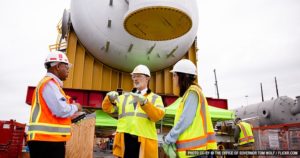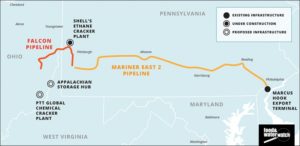US Politicians (including some Democrats) are pushing dangerous projects to prop up the plummeting profitability of natural gas fracking.
If these massive petrochemical, plastics, and pipeline investments are not stopped, people who live nearby will have the steepest price to pay — with their health and their environment.

The big secret is out — fracking hasn’t been as profitable as the industry thought it would be. Prices and profits have been crashing, so gas and oil companies have been racking their brains to find new ways to market fracked gas to get a return on their money. The industry’s clever answer to their financial troubles lies in plastics, because the petrochemical industry can make plastic out of the fracked gas.
The fracking and petrochemical industries have teamed up to dump tens of billions of dollars into the heart of the Appalachian region — right where Pennsylvania, Ohio, and West Virginia meet. They are building pipelines and petrochemical and plastics manufacturing complexes, and a large underground storage facility. Our research team has released a damning issue brief that underscores the partnership between these polluting industries, elected officials, and regional universities to launch a massive petrochemical and pipeline boom.

So Wait — Fracking Isn’t Profitable?
In the race to turn a profit, the oil and gas industry drilled thousands of fracked wells in the Tri-State area of Ohio, Pennsylvania, West Virginia and across the country. As a result, natural gas production surged six-fold in a decade to 16.9 quadrillion cubic feet by 2017.
But, whoops: They forgot the whole supply and demand thing, and six times more gas made prices plummet by 60 percent. The prices fell to the lowest levels in decades, making it difficult to justify fracking new wells for new gas that would only push prices down further.
Now the fracking industry needs new demand sources to absorb excess gas to justify more drilling. Cue the plastics industry.
Re-Tooling To Supply Their New Profit Source
Natural gas is mostly comprised of dry methane, with smaller amounts of other hydrocarbons called natural gas liquids (NGLs). The petrochemical industry can manufacture natural gas liquids present in certain fracked gas reserves to produce key chemicals that make plastics — especially ethane, which is abundantly found in the Marcellus and Utica shale basins of the Tri-State area. This created a mutually profitable polluting partnership that would give the petrochemical industry lower-cost supplies and give the fracking industry a new outlet to sop up excess gas supplies, halting the free fall in prices and encouraging more fracking.
This partnership needed a huge investment: An estimated $26 billion to $35 billion is being poured into the Tri-State area to make new petrochemical, plastic, storage and pipeline infrastructure. That investment includes petrochemical complexes that would convert natural gas liquids into the chemical ingredients to make plastic, plastics manufacturing factories, pipelines, and the huge Appalachian Storage Hub to hold and distribute the supply of fracked gas.
The goal: convert the Appalachian region into a petrochemical rival to the Gulf Coast. This could turn the upper Ohio River Valley into the next “Cancer Alley.” The petrochemical cheerleaders don’t tell communities that the Gulf Coast has some of the highest levels of pollution and pollution-related diseases and illnesses. The region already has endured decades of industrial pollution that has left a stark environmental legacy. The buildout of new petrochemical, plastic and fracked gas infrastructure would compound the existing pollution problems, releasing volatile organic compounds, carbon monoxide, nitrogen oxides and other toxins.
Help From Elected Officials And Universities
Any harmful industry looking to prey on an area for profit needs help to make its plan acceptable in the eyes of the public — and the fracking industry didn’t have to look far. Politicians who receive big money from the oil and gas industry were there to lend a hand. The governors of Ohio, Pennsylvania and West Virginia formed the Tri-State Shale Coalition to jump start this petrochemical and fracking infrastructure investment. The governors incubated partnerships between public universities and the energy companies to provide the pretense of objectivity to this petrochemical building boom.
Read More About The Many Hazards Of This “Fracketeering” Project
It’s a comprehensive web of pipeline interests, politicians and plastics prospecting and our researchers knew this story had to be told. The people who will pay the price for this Hail Mary pass to save fracking are the nearby communities that bear the risk for pollution-related illnesses and industrial and pipeline catastrophes like the explosion of a pipeline just 7 days into operation in Western Pennsylvania this month. Not to mention the significant environmental threats to local ecosystems. We want you to stand against it with us, and to do that, you have to know that it’s happening.


